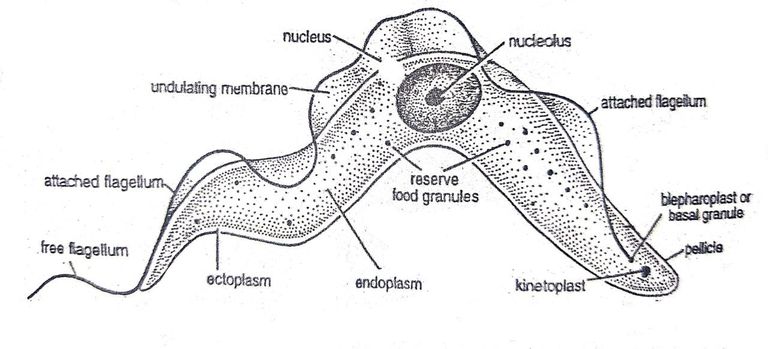
Image source : General Characteristics of Trypanosoma gambiense | Diagram
Trypanosoma gambiense is a parasitic protozoan that causes human African trypanosomiasis, also known as sleeping sickness. It is one of the two subspecies of Trypanosoma brucei, the other being Trypanosoma rhodesiense, which causes a similar but more acute form of the disease. T. gambiense is transmitted to humans through the bite of the tsetse fly, which is found in rural areas of West and Central Africa.
The parasite primarily affects the central nervous system, causing symptoms such as fatigue, headaches, and insomnia. As the disease progresses, it can lead to neurological problems such as confusion, difficulty walking, and seizures, and even death if left untreated. The disease is characterized by two stages, the first of which is an acute stage that lasts several months and is characterized by symptoms such as fever, swollen lymph nodes, and skin rash. The second stage, which can last for years, is characterized by neurological symptoms.
T. gambiense is found in West and Central Africa, and it is estimated that around 300,000 people are infected with the parasite. The disease is most common in rural areas and among people who are involved in hunting, farming, and other activities that bring them into contact with tsetse flies. The disease disproportionately affects poor and marginalized communities and can have a significant impact on economic development.
Diagnosis and treatment of T. gambiense infection can be difficult and prolonged. The disease is often misdiagnosed due to its similarity to other diseases such as malaria, and laboratory tests are required for a definitive diagnosis. There are several drugs available for treatment, but they can have serious side effects and are not always effective. Treatment usually requires several months of therapy and close monitoring to ensure that the parasite is eliminated.
There is currently no vaccine available to prevent T. gambiense infection. Control of the disease primarily involves measures to reduce human-tsetse fly contact, such as clearing brush, using insecticides, and educating the public about the risk of infection. Research is ongoing to develop new drugs and vaccines for the disease.
In conclusion, Trypanosoma gambiense is a parasitic protozoan that causes human African trypanosomiasis, also known as sleeping sickness. It is transmitted to humans through the bite of the tsetse fly, and primarily affects the central nervous system, causing symptoms such as fatigue, headaches, and insomnia. The disease is found in West and Central Africa and affects poor and marginalized communities with a significant impact on economic development. Diagnosis and treatment of the disease can be difficult and prolonged, and there is currently no vaccine available to prevent infection.